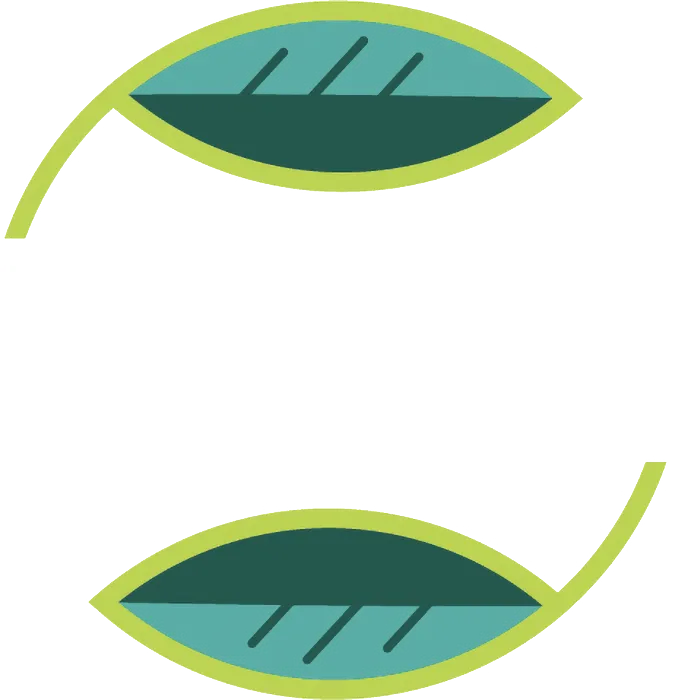2024-03-08
Rubber Mulch for Playground Covering vs. Wood Mulch
Creating the perfect playground or landscaping project involves more than aesthetics; it requires careful consideration of the materials used, especially when choosing the right mulch. Rubber and wood mulch offer distinct advantages and potential drawbacks, and deciding between them is crucial to planning. This article comprehensively compares rubber versus wood mulch, delving into appearance, cost, installation, maintenance, and environmental impact. We aim to provide a detailed guide that helps you make an informed choice based on your specific needs, whether designing a safe playground or enhancing a garden.
Key Topics
- Safety and impact absorption vs. natural look
- Initial affordability vs. long-term durability
- Installation and upkeep differences
- Environmental impact and soil health
Choosing the right mulch involves weighing these factors against your project’s requirements and goals. Rubber and wood mulch are each suited to different landscaping and playground needs, and considerations of longevity, aesthetic appeal, and ecological responsibility will influence your decision. Ultimately, matching your project’s needs with the attributes of each mulch type ensures a harmonious balance between practicality, beauty and environmental sustainability.

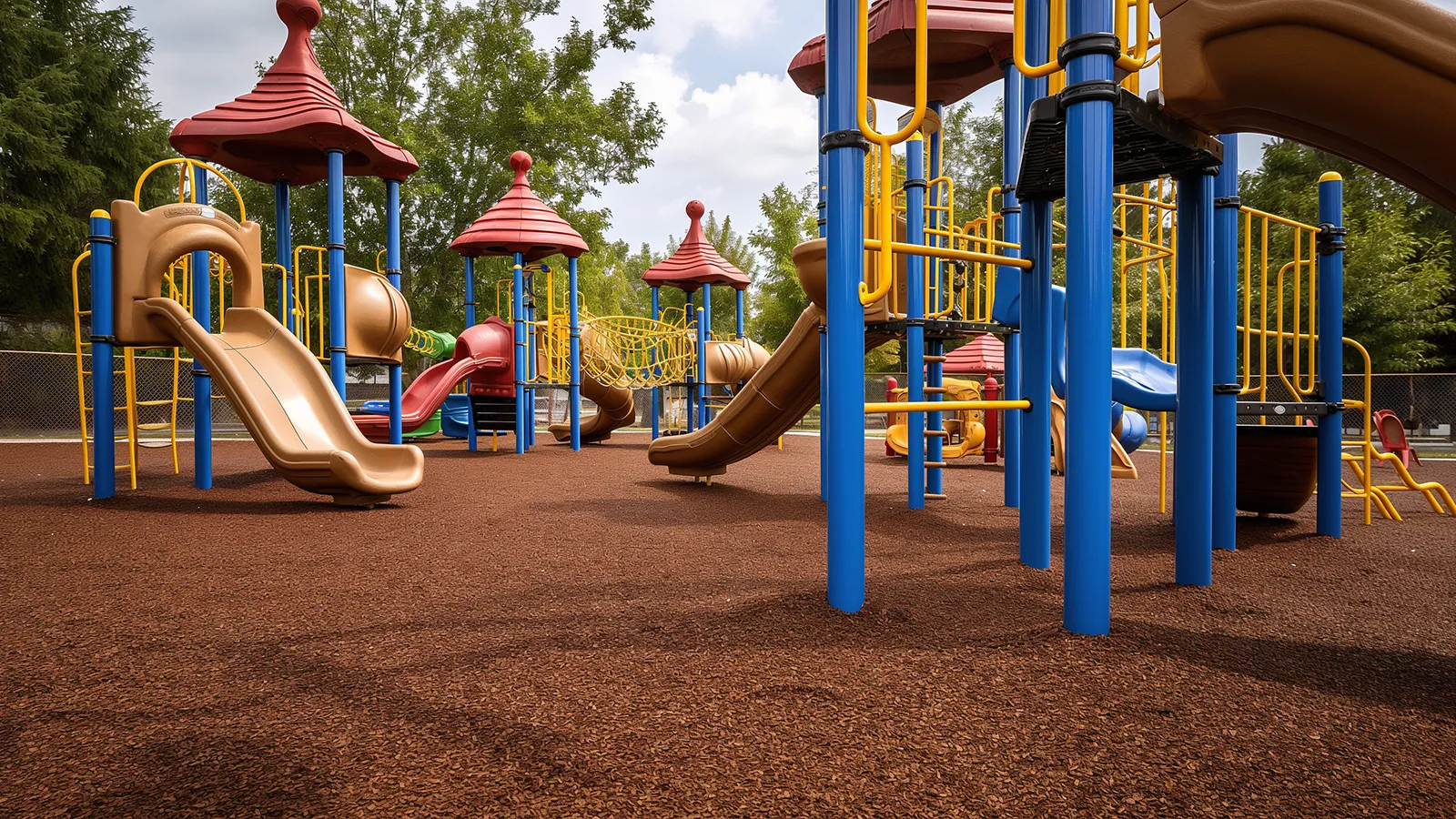
Rubber Mulch: A Durable and Recycled Solution
Rubber mulch, made from recycled tires, is celebrated for its durability and minimal maintenance requirements. Unlike wood mulch, rubber mulches do not decompose, mold, or fade quickly, ensuring that playgrounds retain their aesthetic appeal and functionality for years. This resilience also means rubber mulch withstands harsh weather conditions, including heavy rain and extreme heat, without being washed away or breaking down.
One of the significant advantages of rubber mulch is its safety aspect. Being softer and more elastic than wood chips, pine needles or gravel, rubber mulch provides superior fall cushioning, reducing the risk of injuries in play areas. Moreover, rubber mulch is resistant to pests like termites and ants, which can be attracted to wood mulch and pose potential risks to children and the structural integrity of playground equipment.
- Durability: Does not decompose, mold or fade quickly, retaining aesthetic appeal and functionality for years.
- Weather Resistance: Withstands harsh weather conditions, including heavy rain and extreme heat, without being washed away.
- Safety: Provides superior cushioning for falls, reducing the risk of injuries in play areas.
- Pest Resistant: Resistant to pests like termites and ants, which can be attracted to wood mulch.
- Minimal Maintenance: Unlike wood mulch, rubber mulches require less frequent replenishment, saving time and resources.
- Environmental Benefit: Reusing tires that would otherwise contribute to landfill waste offers an eco-friendly solution.
However, concerns have been raised about the chemicals and metals that could leach from the recycled tires into the soil, potentially harming plant growth. While studies continue to assess these impacts, rubber mulch’s environmental benefit of reusing tires that would otherwise occupy landfill space cannot be overlooked.
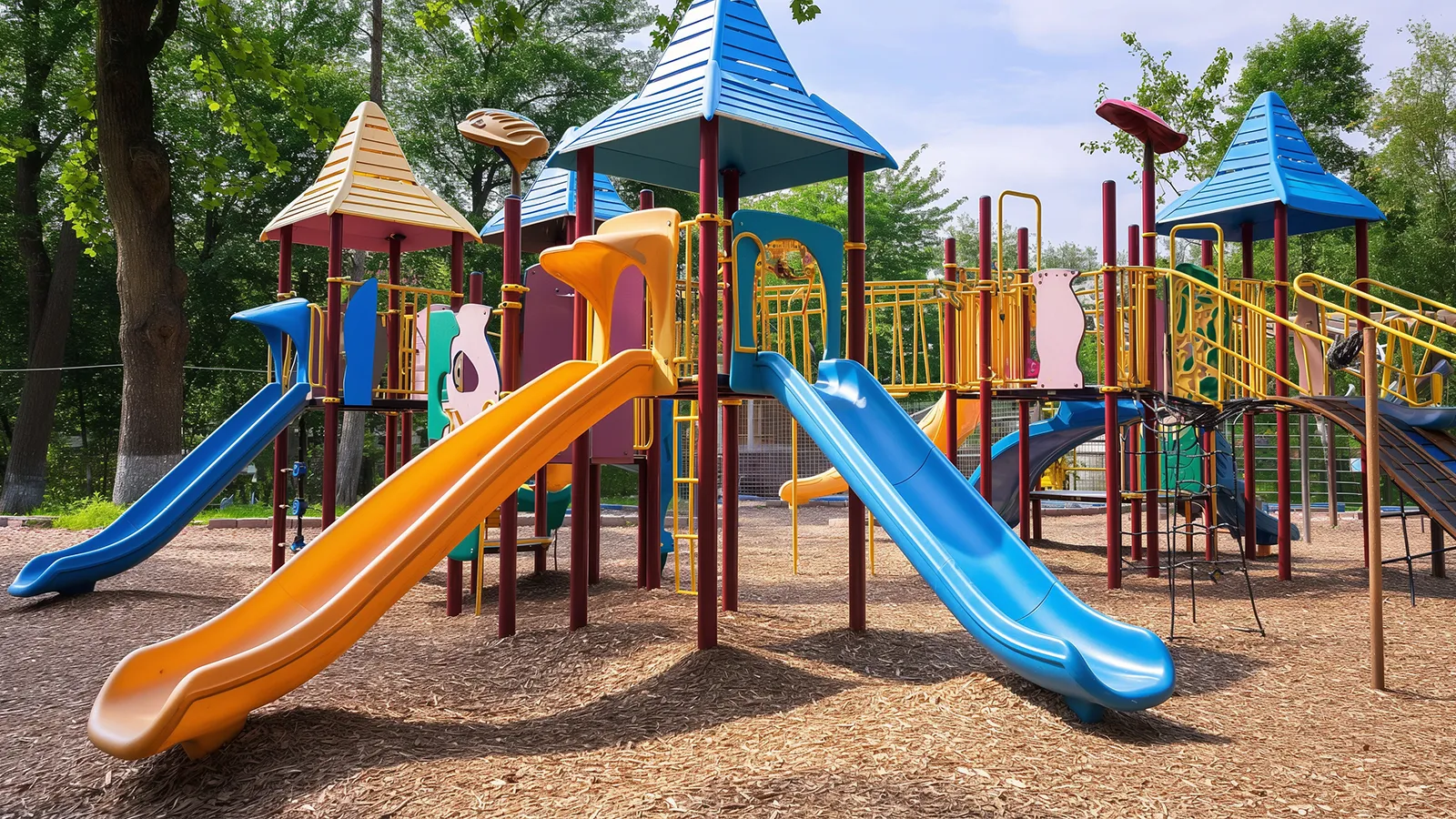
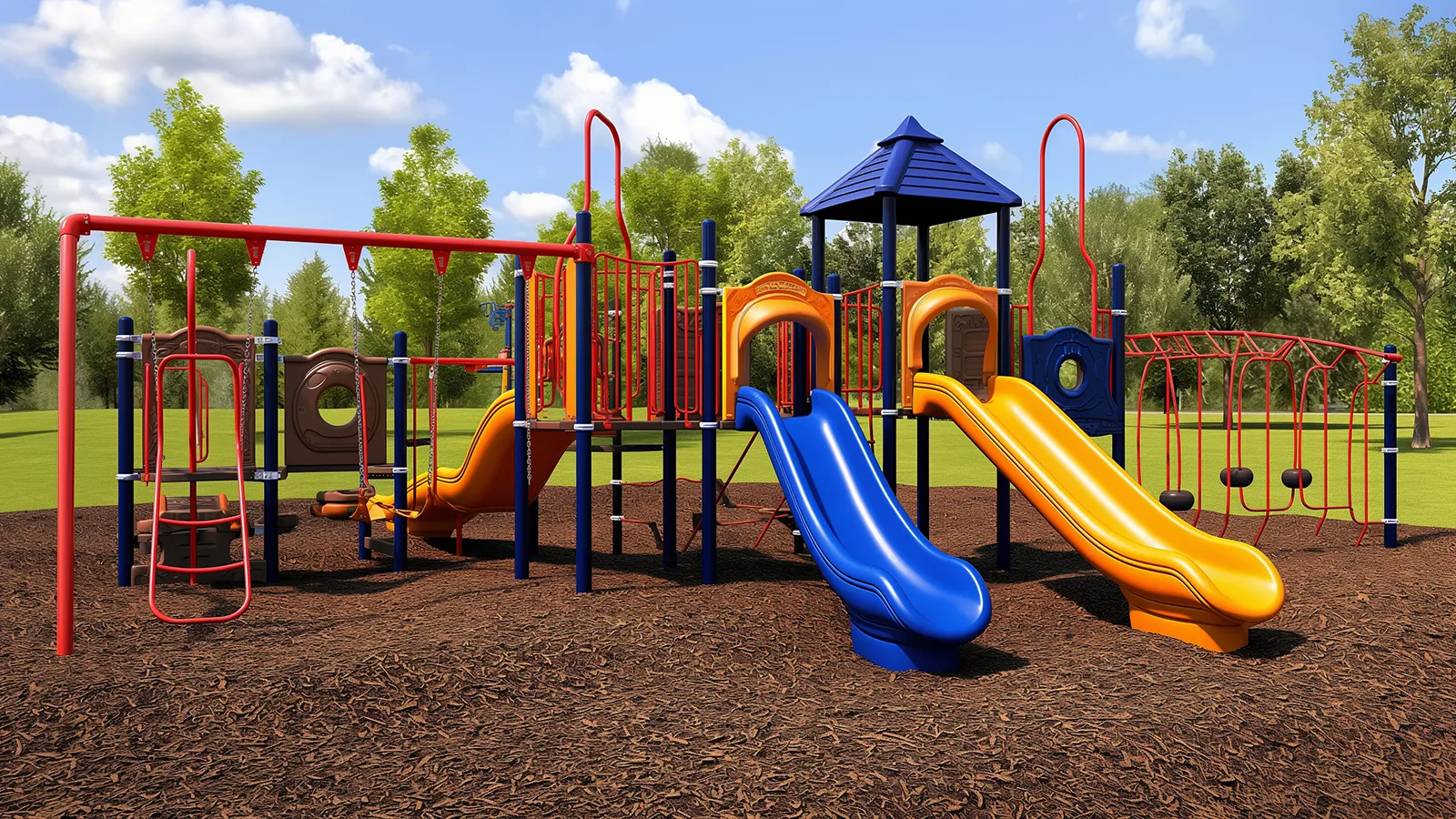
Wood Mulch: A Natural and Aesthetic Choice
Wood mulch, encompassing varieties such as wood chip mulch, bark mulch, and natural wood mulch, is prized for its organic matter content and contribution to soil health. As wood mulch decomposes, it enriches the soil with nutrients, promoting plant growth around the playground. This natural decomposition cycle, however, means wood mulch requires more frequent replenishment than its rubber counterpart, increasing maintenance efforts and costs.
Wood mulch offers a traditional aesthetic appeal that seamlessly blends into natural landscapes. It is available in various colors and types, including brown bark mulch and lighter pine needles, allowing for versatile landscaping designs. Furthermore, it helps retain soil moisture, supports plant health, and suppresses weed growth more effectively than rubber mulch.
- Soil Enrichment: As it decomposes, it adds organic matter to the soil, enhancing plant growth.
- Aesthetic Appeal: Offers a traditional look that blends well with natural landscapes in various colors and types.
- Moisture Retention: Helps retain soil moisture, promoting healthy plant and root development.
- Weed Suppression: Effectively suppresses weed growth, reducing garden maintenance.
- Pest Attraction: Can attract termites and other insects, potentially posing risks to wooden structures nearby.
- Maintenance: Requires more frequent replenishment than rubber mulch due to decomposition.
Yet, wood mulch has its downsides. It can attract termites and other insects, threatening nearby wooden structures. Additionally, its susceptibility to mold and tendency to blow away in strong winds or wash away during heavy rain can increase upkeep demands.
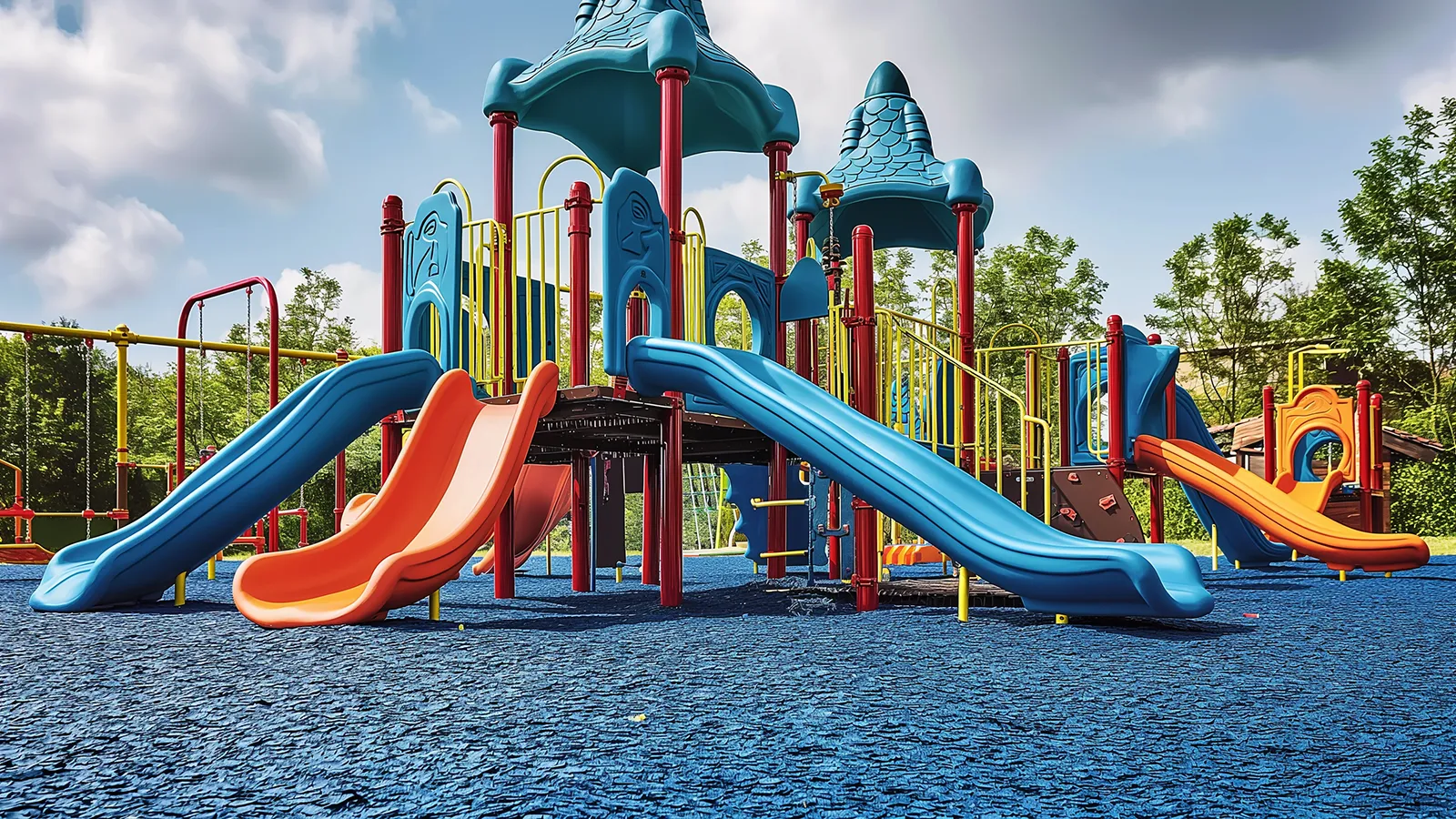
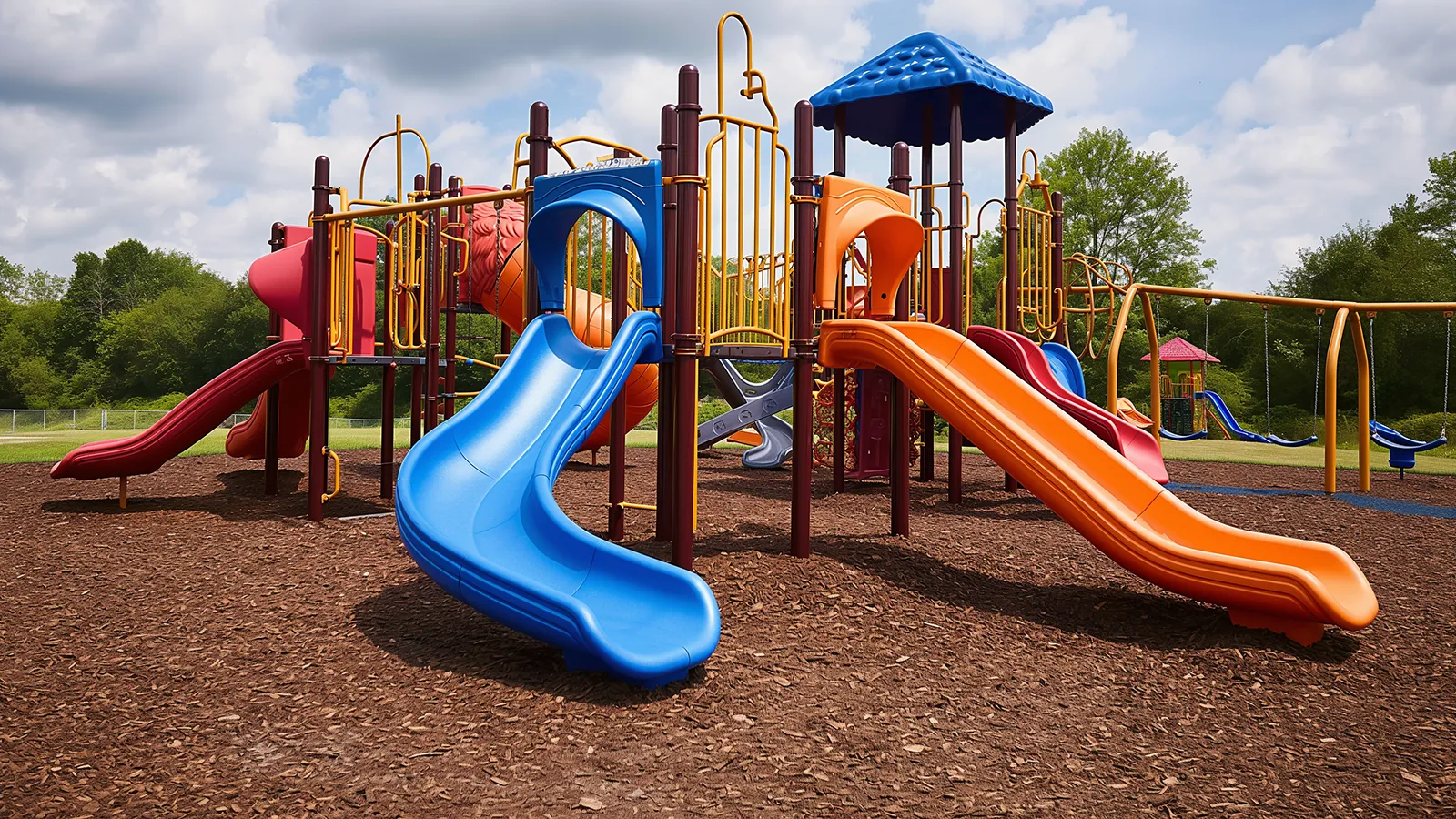
Rubber vs. Wood Mulch: Weighing the Factors in Detail
Choosing the right mulch for your landscaping or playground project involves evaluating a complex matrix of factors, each with its own set of impacts on the environment, safety, maintenance, and aesthetics. Rubber and wood mulch are popular choices, yet they diverge significantly in their properties and implications for use. This detailed comparison aims to shed light on the nuances between rubber and wood mulch, helping you navigate through their benefits and drawbacks. By dissecting aspects such as appearance, cost, installation, maintenance, environmental friendliness, health and safety, and specific applications, we equip you with the knowledge to make an informed decision that best suits your project’s requirements.
Appearance
Both rubber and wood mulch offer unique visual appeal to landscapes and play areas, each with characteristics that might appeal to different preferences and project requirements. Rubber mulch can mimic the look of natural wood chips but offers a broader range of colors, including both vibrant and pastel shades that maintain their appearance over time. Wood mulch, however, boasts a natural and organic look that blends effortlessly into garden settings, though its color options are more limited and natural.
Rubber Mulch:
- Looks like wood chips but available in a wider color palette
- High-end products are designed to resist fading
- Bright and pastel colors can complement playground equipment or garden themes
Wood Mulch:
- Offers a natural, organic appearance that enhances the landscape’s beauty
- Typically, it does not fade, preserving the garden’s look
- Color options are naturally limited but add to its authentic appeal
Appearance plays a crucial role in the selection process, affecting the overall look and feel of the landscaping or playground area. While rubber mulch provides a durable and color-diverse option, wood mulch delivers a classic and natural aesthetic that many find appealing for its authenticity and integration with the natural environment.
Cost
The cost of mulch can significantly influence decision-making, especially for larger projects. Rubber mulch generally carries a higher price tag due to its longevity and durability, while wood mulch is more affordable but may require more frequent replacement. The choice between rubber and wood mulch could come from initial budget constraints versus long-term investment considerations.
Rubber Mulch:
- Generally more expensive, ranging from $80 to $160 per cubic yard
- Additional costs for installation, delivery, and potentially landscape fabric
Wood Mulch:
- More budget-friendly, with prices ranging from $30 to $110 per cubic yard
- Lower initial cost, but consider additional expenses for replenishment and delivery
Cost considerations extend beyond the initial purchase price to include long-term maintenance and replacement expenses. Rubber mulch, while more costly upfront, may offer savings over time due to its durability and lower maintenance needs, making it a potentially wise investment for those prioritizing longevity and minimal upkeep.
Installation
The installation process for rubber and wood mulch involves labor and preparation, but each material has nuances. Rubber mulch, being heavier, tends to stay in place better in windy conditions but requires a fabric barrier to prevent integration with the soil, adding to the complexity of installation. Wood mulch is lighter and easier to spread but can be messier and more prone to displacement.
Rubber Mulch:
- Heavier, reducing the likelihood of displacement by wind
- Requires a landscape fabric barrier, increasing installation time
Wood Mulch:
- Easier to spread and adjust due to its lighter weight
- No landscape fabric barrier is needed, simplifying installation
Installation considerations are key to planning your project, as they can affect the timeline and the complexity of the work involved. Wood mulch might be the better option for those looking for ease and simplicity. However, rubber mulch could be preferred as a more durable solution that withstands the elements better despite its installation challenges.
Maintenance
Maintaining the appearance and functionality of mulched areas is an ongoing task, with rubber and wood mulch presenting different maintenance profiles. Rubber mulch’s weight helps it stay in place, reducing the need for regular adjustments, and it’s less susceptible to mold and insect problems. Wood mulch, while offering a more natural aesthetic, requires frequent replenishment and care due to its propensity to move, degrade, and attract pests.
Rubber Mulch:
- Stays in place better due to its weight, reducing maintenance
- Less prone to mold and insect issues, simplifying care
Wood Mulch:
- Needs more frequent replenishment as it degrades
- Can move and attract pests, requiring regular maintenance
Maintenance efforts can significantly impact the long-term enjoyment and appearance of your landscaped or play areas. While rubber mulch may offer a more hands-off approach, wood mulch demands a more engaged maintenance routine, which could be a deciding factor for those weighing ease of care against natural aesthetics.
Environmental Friendliness
Environmental considerations are increasingly crucial in landscaping choices, with rubber and wood mulch having distinct impacts. Rubber mulch is praised for repurposing used tires and reducing landfill waste. Still, it raises concerns over soil contamination and the leaching of harmful chemicals. Wood mulch, as a natural product, decomposes and enriches the soil without introducing contaminants, assuming it is sourced sustainably and untreated.
Rubber Mulch:
- Diverts waste from landfills but may leach chemicals into the soil
- Potential for contamination of groundwater with heavy metals and chemicals
Wood Mulch:
- Sustainable and renewable when sourced ethically
- Enhances soil quality without the risk of contamination
Environmental friendliness encompasses mulch use’s immediate and long-term impacts on the surrounding ecosystem. While rubber mulch offers a recycling benefit, the potential for adverse ecological effects may outweigh this advantage. Wood mulch, conversely, supports a cycle of natural decomposition and soil enrichment, aligning with eco-friendly landscaping practices.
Health and Safety
The health and safety of those using the mulched areas, especially children and pets, are paramount. Rubber mulch has been scrutinized for releasing VOCs and potentially harmful chemicals, which can pose risks to soil health and plant life. Wood mulch is generally safer in terms of chemical exposure. However, it can attract pests and may harbor mold, which could cause allergies or other health issues.
Rubber Mulch:
- Lower fire safety due to easier ignition and faster, hotter burning
- Risk of chemical exposure from VOCs and leached substances
Wood Mulch:
- Safer for growing edible plants with no VOC emissions
- Less of a fire risk but may attract pests and harbor mold
Health and safety concerns can significantly influence the choice between rubber and wood mulch. The lower chemical risk associated with wood mulch might be preferable for areas around edible plants or where children and pets frequent. However, pest control and mold prevention considerations also play a part in the decision, highlighting the need to balance various health and safety factors.
Specific Applications
Determining the best mulch for specific uses involves considering all the abovementioned factors in light of the intended application. For edible gardens, wood mulch’s natural benefits to soil and plant health make it the clear choice. Play areas present a more balanced debate, with rubber mulch’s durability and safety features competing against wood mulch’s natural feel and lower chemical concerns.
- Edible Gardens: Wood mulch is preferable for its contribution to soil health and lack of harmful chemicals.
- Play Areas: The choice is more nuanced, with safety and maintenance considerations possibly favoring rubber mulch, while wood mulch offers a natural, chemical-free option.
The best mulch for a project depends on aesthetic preferences, budget constraints, installation capabilities, maintenance willingness, environmental values, and health and safety priorities. By carefully considering each factor in relation to your specific needs, you can choose the mulch that best aligns with your landscaping goals and values, whether it be the durable and colorful rubber mulch or the natural and enriching wood mulch.
Alternative Mulch Options
Exploring alternative mulch options can offer unique benefits and drawbacks tailored to specific landscaping needs, preferences, or challenges. Beyond the widely used rubber and wood mulches, materials like straw, landscaping fabric, pine needles, yard waste, and rocks or gravel present various characteristics suited for different applications. These alternatives can provide solutions ranging from cost-effectiveness and environmental sustainability to ease of installation and maintenance. Considering these options allows for a customized approach to mulching, optimizing for factors such as moisture retention, weed suppression, soil health, and aesthetic appeal.
- Straw Mulch: Economical and effective for moisture retention, ideal for vegetable gardens and protecting soft fruits. Needs annual replacement but enriches the soil.
- Landscaping Fabric: Durable weed barrier that allows water and airflow, often used under decorative mulch for enhanced weed control. Cost-effective and reduces the need for chemical weed killers.
- Pine Needles: Provides a natural, acidic environment for acid-loving plants, with excellent water penetration and retention. Aesthetically pleasing with a fresh, natural look.
- Yard Waste: Utilizes leaves, grass clippings, and other organic waste, offering a free and eco-friendly option. Can vary in appearance and may need monitoring for pests.
- Rocks and Gravel: Low maintenance and durable over time, suitable for xeriscaping and areas with low water use. Prevents soil erosion and effectively suppresses weeds.
Choosing an alternative mulch option often depends on the specific goals of a landscaping project. For instance, straw mulch is excellent for vegetable gardens, where it decomposes into valuable organic matter. Landscaping fabric can be a foundational layer beneath a more decorative mulch for long-lasting weed suppression. Pine needles, attractive and beneficial for acid-loving plants, offer aesthetic and functional advantages. Ultimately, selecting an alternative mulch should align with the garden or landscape’s specific environmental conditions, aesthetic preferences, and maintenance expectations.
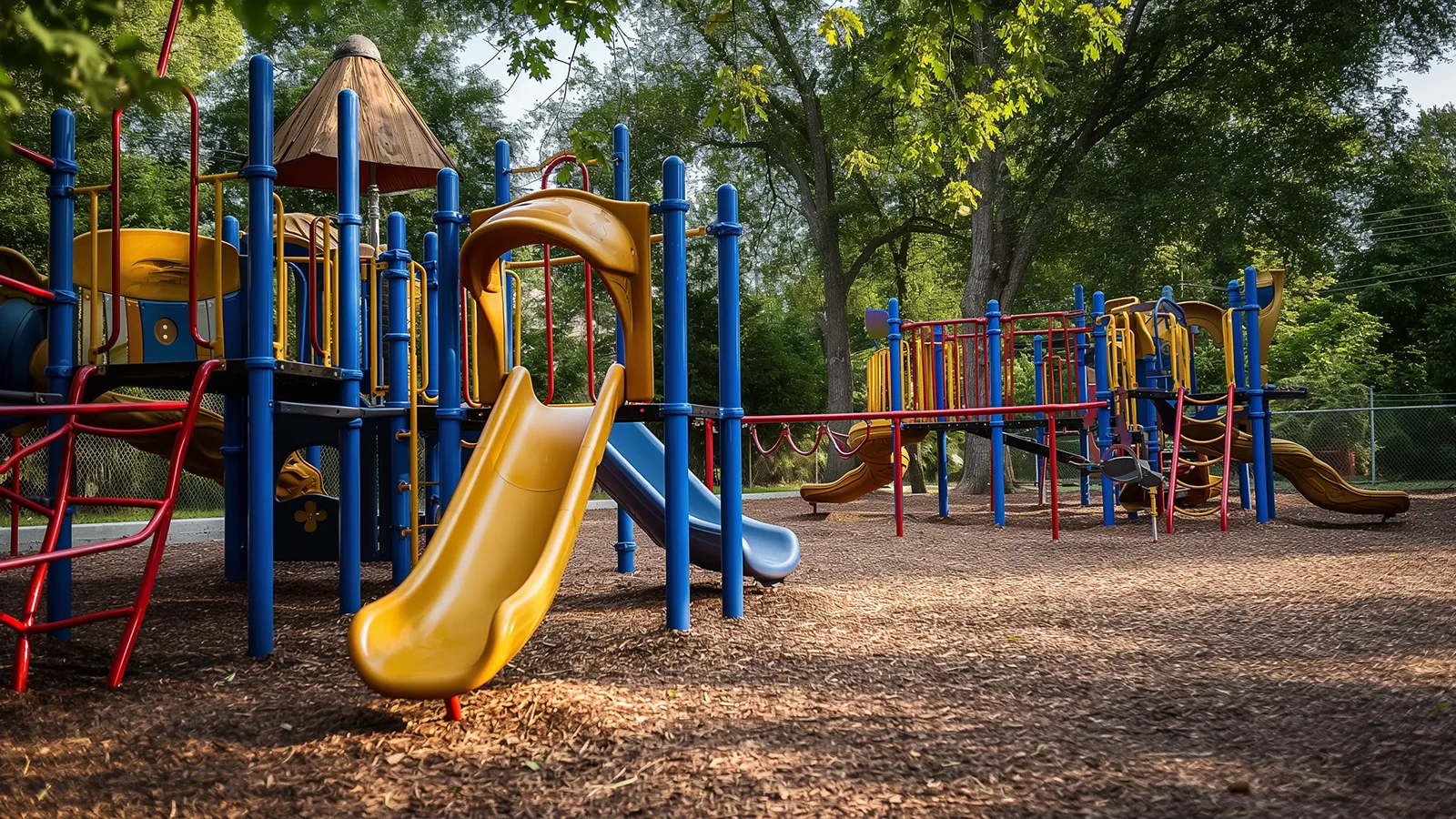
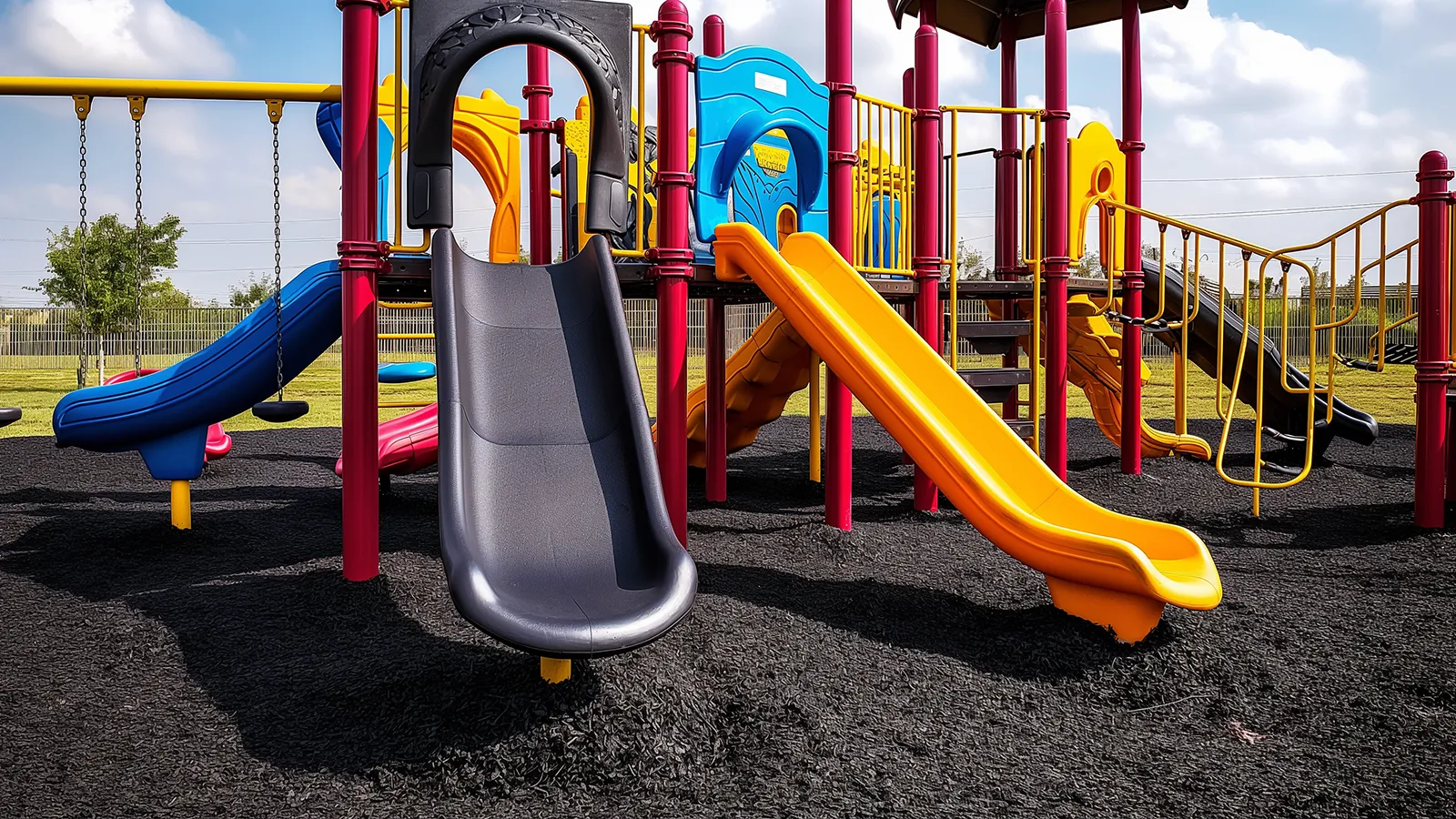
Finding Your Perfect Match
Navigating the myriad choices in the mulch market can feel like an overwhelming quest. However, armed with detailed comparisons and insights into traditional options like rubber and wood mulch and alternative materials, you’re well-equipped to make an informed decision that aligns with your landscaping goals. Whether prioritizing durability, aesthetic appeal, soil health, or environmental sustainability, the key lies in balancing these factors against your specific needs and preferences. Remember, the perfect mulch for your project not only enhances the visual charm of your space but also contributes to the health and longevity of your garden or playground.
By thoughtfully considering the attributes of each mulch type, you’ll uncover the ideal solution that meets your practical requirements while reflecting your personal style and environmental values.





